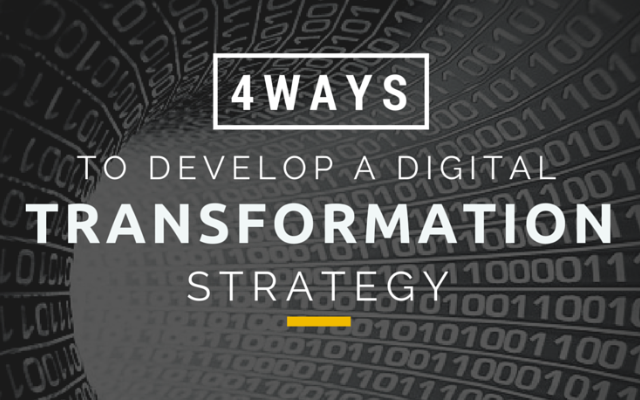Much has and will be discussed around the topic of “digital transformation,” which has become a buzzword in today’s digital world. However, it is important to face the truth and the challenges about where companies really are before they can begin their digital journey.
In today’s digital economy, information is a new currency. As Eric Schmidt, Google chairman, once said, we create as much information every two days as we did from the beginning of history up to 2003. A study by IBM suggests that around one trillion devices will be connected to the Internet by the end of 2015.
It can be said that we are living through the biggest technological shift of all time, which makes this a very disruptive time. Therefore, companies cannot afford to ignore this phenomenon. To thrive or even to survive, they should use technology to improve their business and engage with customers.
Technology can be a powerful tool, but it is just an enabler, enabling businesses to drive their business forward, open new markets and new possibilities, and engage and interact with their customers in real time.
Take, for example, Amazon: if Amazon were a country, it would be the world’s 86th largest, with revenue of $34.2 billion, greater than Kenya’s GDP. If Facebook, with 1.39 billion users, were a country, it would be the most populous nation on earth, bigger than the entire population of China.
Some say, the world is transforming towards digital. In fact, the world has already been transformed into a digital one. The question is: Is your organisation ready for the digital transformation?
According to Didier Bonnet, the Global Practice Leader Digital Transformation at Capgemini, companies that use digital technologies to drive higher profits, productivity, and performance are called “digital masters.” Digital mastery can be achieved by reinventing business models, creating better products and services, creating new digital businesses, and re-thinking value propositions through digital technologies.
The rise of big data, the Internet of things, mobile computing, wearable technology, self-driving cars, and even robots will force companies to rethink their business plan and take digital transformation more seriously. As Marc Andreessen, venture capitalist, once said for Wall Street Journal, “Software is eating the world”. Therefore, every business needs not only to go digital but also mobile, because, nowadays, there are more mobile phones on the earth than people.
BCG claims that data about customers, companies, suppliers, and employees is exploding. Ninety percent of all that data was created in the past two years. By the end of 2016, there will be around 3 billion people globally using the Internet, and the Internet economy will reach $4.2 trillion in the G-20 nations.
Assuming that your organisation decides to go digital, where do you start the digital transformation journey? Didier Bonnet suggest that you first need to understand the starting point by asking question such as: Is my company a digital master already? Or is it somewhere between “beginner,” “fashionista,” “conservative, or digital masters” as he calls them.
Once you know where your organisation stands, then you can think about how your company uses digital technologies, such as social media, mobile, analytics, and other embedded devices. Are you building digital capabilities in customer experience or operation? Are you digitally improving your existing business model or creating a new one? Once you’ve answered these questions, you can then follow a transformation compass, which enables you to steer the course of this complex journey, which is more of a linear process.
The first step of this transformation process, is framing the digital challenge – meaning that you need to build an awareness of digital opportunities and threats, knowing your starting point and assessing your digital maturity. Then you need to create a vision and ensure that your senior team is aligned around it. As a leader, you need to create momentum around the entire digital transformation process by addressing the above questions early in process.
Once you’ve framed the digital challenge, the second step, is focusing your investments – meaning translating your vision into an actionable roadmap, building a cross-silo governance structure, and putting in place the funding for the transformation process.
Once you’ve secured the investment, the third strep in the process is mobilizing the organisation by communicating your ambitions and the changes needed now as well as building a momentum and engaging the workforce. Also, you need to establish new behaviour and start changing the organisation’s culture toward a more innovative one.
The last, but definitely not least, the fourth step is sustaining the transition – meaning building the strong foundational skills, aligning reward structures to overcome traditional organisation barriers, monitoring and measuring the process of transformation over time. However, a successful transformation of your organisation will not happen unless you have the capabilities, leadership, and commitment from senior team to execute your vision.
Depending on your industry, digital transformation can be a challenge, particularly in highly regulated industries such as financial services and healthcare, but that doesn’t mean it is not achievable. Often, digital transformation fails as a result of losing momentum and the commitment of the senior team. Therefore, leaders need to be able to earn employees’ trust, engage them, and mobilise them towards the common goal of digital transformation. Other reasons why some companies fail to digitally transform themselves are because they lack either the digital capabilities or leadership capabilities required to set a vision and execute on it.
The best way to drive the transformation is through a top-down process with the full support of senior executives, engaging the whole staff and making it a shared vision of, “We are all working together to make this transformation happen.”
There are several companies that have successfully led their digital transformation strategy, but one that stands out from the crowd is Nike. According to its CEO, Mark Parker, Nike is not a sports footwear company. It is an innovation company that keeps innovating through digital technologies. As a result of this, Nike customers now can design and create their own shoes on their own time. This has enabled Nike to not only improve the business performance but also improve operations, increase profits, reduce waste, improve corporate social responsibility, strengthen their global supply chain, and engage better with and stay closer to their customers.
Nike can be regarded as a true ‘digital master’ because it has created a new business unit called Nike Digital Sport building new digital products and rethinking how Nike can better engage with their customers across different platforms. As Nike’s digital brand director, Jesse Stolak, said, they are no longer just a seller of products but have also become part of their customer’s lives.
Didier Bonnet from Capgemini further argues that digital transformation is not about digitizing reality; it is about the impact of digital reality on real-world businesses. To succeed like Nike, you need to inform all stakeholders towards the digital vision and leverage digital technologies to drive your business forward. Research by Capgemini suggests that companies that use technology achieve higher profits, higher productivity, and better performance. Digital masters outperform their peers by achieving 26% more profit than their competitors.
To stay relevant and competitive in this digital economy, many companies are creating digital steering committees to set a vision for companies to aspire and work towards that vision before it becomes too late. Digital drivers need to build a strong relationship with their IT department, marketing department, and senior executives to drive change. It is known that digital masters do more than just invest in digital capabilities. They recreate the leadership capabilities to get the most from their digital activities. Furthermore, in the age of huge disruption and innovation, companies have no choice but to transform their business now.
To sump up briefly, the Internet, which is only 25 years old, will continue to influence everything. The Internet of things, mobile, social media, self-driving cars, and robots will have a profound influence on business, life, and the global economy. Every company will soon have to adapt to the new digitally transformed environment or otherwise face huge consequences and losses in the long run.
Although becoming a digital master is a big challenge, it is achievable for any business, given that you have all the necessary digital and leadership capabilities mentioned above. Therefore, digital transformation strategy should be a top priority for every business that wants to not only prosper but survive. That’s because this digitally transformed world we luckily live in will be digital sooner rather than later and where customers expect companies to engage, interact, co-create, and stay relevant.
What do you think? Is your organisation ready for the digital transformation? Do you have the right IT infrastructure, capabilities, and leadership buy-in to meet the challenges ahead? Please share your thoughts and experience in the comments below.
Article by channel:
Everything you need to know about Digital Transformation
The best articles, news and events direct to your inbox
Read more articles tagged: Featured






